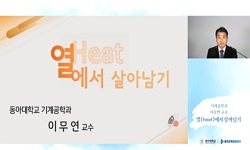Heat transfers and related phenomena can be described by the second order partial differential equation, which cannot generally be solved except a simple domain. To make matters worse, the solution significantly dependents on the boundary conditions. ...
http://chineseinput.net/에서 pinyin(병음)방식으로 중국어를 변환할 수 있습니다.
변환된 중국어를 복사하여 사용하시면 됩니다.
- 中文 을 입력하시려면 zhongwen을 입력하시고 space를누르시면됩니다.
- 北京 을 입력하시려면 beijing을 입력하시고 space를 누르시면 됩니다.
https://www.riss.kr/link?id=A100467584
- 저자
- 발행기관
- 학술지명
- 권호사항
-
발행연도
2014
-
작성언어
Korean
-
주제어
전산해석 ; 전열해석 ; 비정렬격자 ; 행렬계산 ; 격자중심방법 ; Numerical methods ; heat transfer ; unstructured grid ; matrix solver ; cell-centered scheme
-
등재정보
KCI등재후보
-
자료형태
학술저널
-
수록면
343-348(6쪽)
-
KCI 피인용횟수
3
- 제공처
-
0
상세조회 -
0
다운로드
부가정보
다국어 초록 (Multilingual Abstract)
Heat transfers and related phenomena can be described by the second order partial differential equation, which cannot generally be solved except a simple domain. To make matters worse, the solution significantly dependents on the boundary conditions. The equations with analytical methods are solvable for only a limited number of cases. The known solutions are extremely useful in helping to understand heat transfer phenomena, but they rarely can be applied in engineering or design, because these solutions are not sufficiently practical. The engineer and designer have generally been forced to use numerical methods instead. To obtain an numerical solution, a discretization method, which approximates the differential equations by a system of algebraic equations is used. The approximations are applied to small domains in space and time so the numerical solution provides results at discrete locations in both space and time. The accuracy of numerical solutions is dependent on the quality of discretizations and size of cells used. The higher accuracy, the higher numerical resource are required. The balance between the accuracy and difficulty of the numerical methods is critical. The final linear equations by discretization are solved with matrix solver, which takes the most of the computation time. To reduce the computation time, the effective method for matrix solver is required. This study provides an overview of discretization, and matrix solver for the 3-dimensional numerical heat transfer.
목차 (Table of Contents)
- Abstract
- 1. 서론
- 2. 전산응용 전열해석
- 3. 결과 및 토의
- 4. 결론
- Abstract
- 1. 서론
- 2. 전산응용 전열해석
- 3. 결과 및 토의
- 4. 결론
- 참고문헌
참고문헌 (Reference)
1 명현국, "비정렬 셀 중심 방법에서 확산플럭스의 새로운 수치근사방법" 한국전산유체공학회 11 (11): 8-15, 2006
2 명현국, "비정렬 셀 중심 방법에서 대류플럭스의 수치근사방법 평가" 한국전산유체공학회 11 (11): 36-42, 2006
3 "THERM WINDOW7"
4 "Physibel"
5 Thompson, J. F., "Numerical grid generation" Elsevier Science Ltd 1985
6 Golub, G. H., "Matrix computations" The Johns Hopkins University Press 2013
7 "HEAT"
8 White, F., "Fluid Mechanics" McGraw-Hill 2011
9 Mathur, S. R., "A pressure-based method for unstructured meshes. Numerical Heat Transfer" 31 : 195-215, 2007
1 명현국, "비정렬 셀 중심 방법에서 확산플럭스의 새로운 수치근사방법" 한국전산유체공학회 11 (11): 8-15, 2006
2 명현국, "비정렬 셀 중심 방법에서 대류플럭스의 수치근사방법 평가" 한국전산유체공학회 11 (11): 36-42, 2006
3 "THERM WINDOW7"
4 "Physibel"
5 Thompson, J. F., "Numerical grid generation" Elsevier Science Ltd 1985
6 Golub, G. H., "Matrix computations" The Johns Hopkins University Press 2013
7 "HEAT"
8 White, F., "Fluid Mechanics" McGraw-Hill 2011
9 Mathur, S. R., "A pressure-based method for unstructured meshes. Numerical Heat Transfer" 31 : 195-215, 2007
동일학술지(권/호) 다른 논문
-
- 한국건축친환경설비학회
- 성남철(Seong, Nam Chul)
- 2014
- KCI등재후보
-
교실내 흡음성능과 스피커 음압레벨에 따른 청취환경 변화
- 한국건축친환경설비학회
- 주문기(Joo, Mun-Ki)
- 2014
- KCI등재후보
-
- 한국건축친환경설비학회
- 주문기(Joo, Mun-Ki)
- 2014
- KCI등재후보
-
공동주택 바닥충격음을 고려한 바닥마감구조 대안별 성능평가
- 한국건축친환경설비학회
- 전인아(Jun, In-Ah)
- 2014
- KCI등재후보
분석정보
인용정보 인용지수 설명보기
학술지 이력
| 연월일 | 이력구분 | 이력상세 | 등재구분 |
|---|---|---|---|
| 2027 | 평가예정 | 재인증평가 신청대상 (재인증) | |
| 2021-01-01 | 평가 | 등재학술지 유지 (재인증) |  |
| 2018-01-01 | 평가 | 등재학술지 유지 (등재유지) |  |
| 2015-01-01 | 평가 | 등재학술지 선정 (계속평가) |  |
| 2013-01-01 | 평가 | 등재후보 1차 FAIL (등재후보1차) |  |
| 2012-01-01 | 평가 | 등재후보학술지 유지 (기타) |  |
| 2010-01-01 | 평가 | 등재후보학술지 선정 (신규평가) |  |
학술지 인용정보
| 기준연도 | WOS-KCI 통합IF(2년) | KCIF(2년) | KCIF(3년) |
|---|---|---|---|
| 2016 | 0.4 | 0.4 | 0.36 |
| KCIF(4년) | KCIF(5년) | 중심성지수(3년) | 즉시성지수 |
| 0.31 | 0.26 | 0.651 | 0.09 |






 ScienceON
ScienceON DBpia
DBpia






